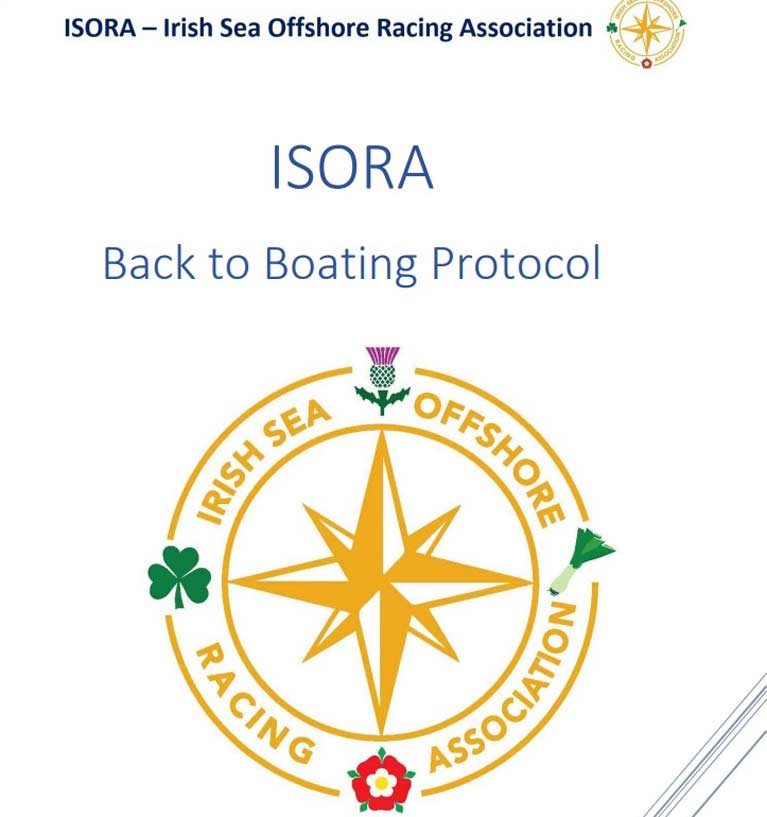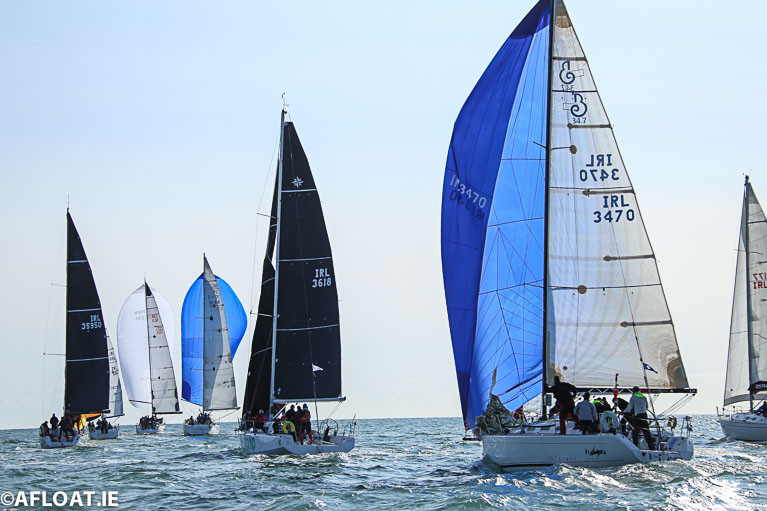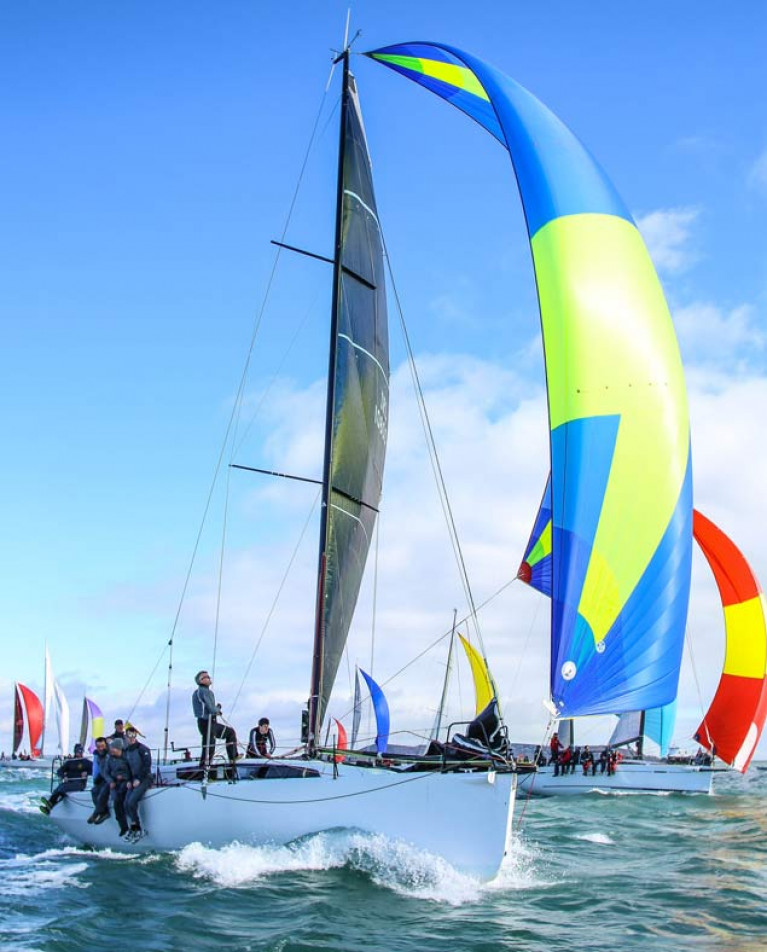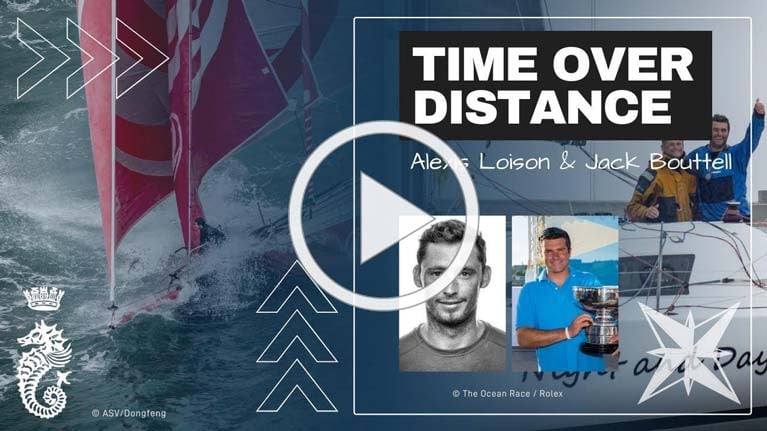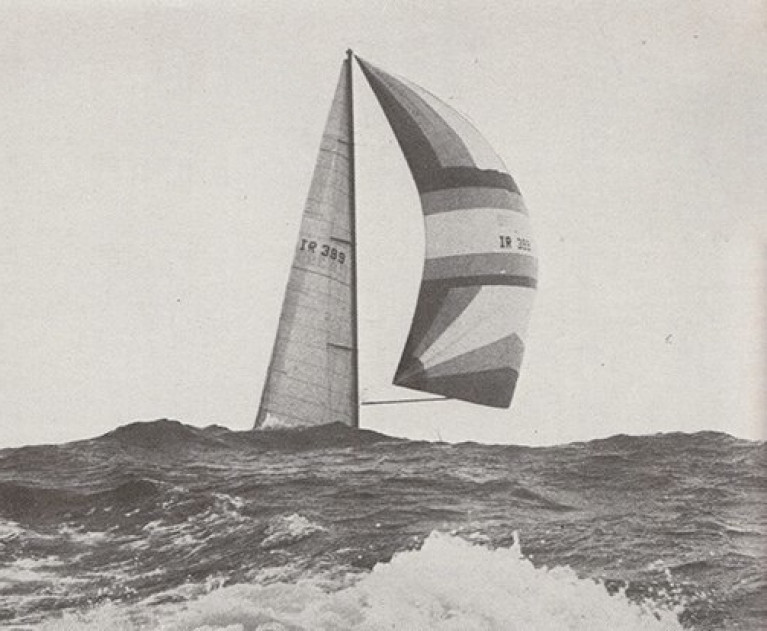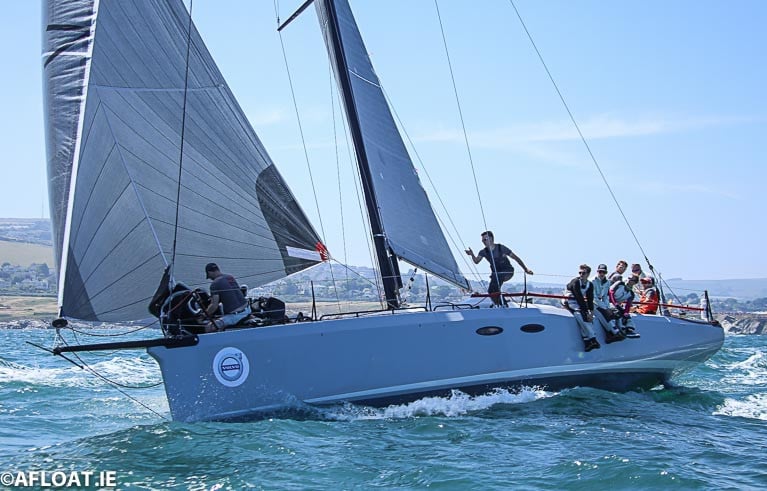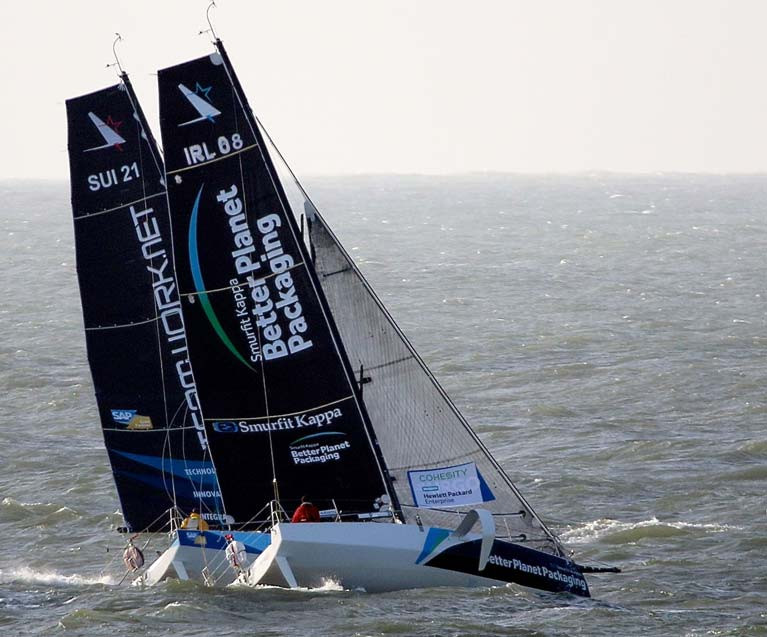Displaying items by tag: Offshore
The Irish Sea Offshore Racing Association (ISORA) is working on a protocol that will allow coastal racing to begin at the end of this month.
The return to full racing, however, hinges strongly on the two-metre social distancing being reduced, according to ISORA Chief, Peter Ryan.
The protocol will be issued early this week, Ryan told Afloat.
Irrespective, ISORA racing will be provided for two-handed and family pods this month. The body is unique in that it provides racing on both sides of the Irish Sea and has a combined fleet of up to 70 boats.
The news is a fillip for Dublin, Liverpool, Isle of Man and Pwllheli racers who are keen to get back on the water after a three-month delay to the summer season. Significantly, a number of key competitors have already been back on Dublin Bay in different crew configurations including some new two-handed combinations. Others, however, are still ashore and some boats still in sheds since lockdown began in March.
The ISORA move chimes with Dublin Bay Sailing Club's plans to resume racing from July 20.
It is proposed that all ISORA starts and finishes would be done using onboard trackers eliminating any need for committee boats.
 Welsh J109 Mojito (Peter Dunlop and Vicky Cox) from Pwllheli is a former ISORA champion Photo: Afloat
Welsh J109 Mojito (Peter Dunlop and Vicky Cox) from Pwllheli is a former ISORA champion Photo: Afloat
If offshore racing resumes on 29th June, it provides further welcome impetus to the season highlight of the 700-mile Round Ireland Race that has been rescheduled for August 22nd. The race has received a buoyant entry to date with 44 entries, the latest being a second Belfast Lough entry over the weekend.
ISORA will at all times comply with the recommendations of Irish Sailing, RYA and RYA Cymru Wales, Ryan confirmed.
Back then, we didn’t know we were living. “Back then” was the first eight or so years of the 21st Century - not forever ago at all. Yet now it feels like not so much a foreign country as more like a different universe. Because back then, there was a buzz. Everything was on the move. It was Action Stations All Areas. It wasn’t a case of “Is it permissible under Government Regulations?” or “Can we do it?” It was more a matter of “When will we do it?” and “How soon will we do it?”
We may now have the makings of a Road Map out of the Covid-19 paralysis, but all the roads in it are long, and some are very winding indeed. As each stage is reached, it will be day-to-day pilotage rather than visionary navigation. And of course, its implementation will all depend on the scourge receding according to the hopeful scientific expectations.
How different it was back then, back when everything was a matter of just get up and go. Of course, there were some crazy episodes. One year, for instance, Ireland had something like three teams racing in the Commodore’s Cup. And they were racing against each other with such determination that there were absurd inter-Ireland protests.
So inevitably we didn’t finally win the Commodore’s Cup until 2010 with its ferocious economic downturn, with a very sober cost-effectively-planned recession-aware single team, put together with infinite patience by Anthony O’Leary and ICRA. But the recession was so deep that there was no defence in 2012, and while the same O’Leary determination won the Commodore’s back in 2014, there was a sense of it being a satisfactory way to end an era, but an unmistakable ending nevertheless.
 “The Red Antix” - Anthony O’Leary’s Ker 40 Antix was RORC “Yacht of the Year” and led Ireland to victory in the 2014 Commodore’s Cup in an outstanding success that marked the end of an era. Photo courtesy RCYC
“The Red Antix” - Anthony O’Leary’s Ker 40 Antix was RORC “Yacht of the Year” and led Ireland to victory in the 2014 Commodore’s Cup in an outstanding success that marked the end of an era. Photo courtesy RCYC
Yet in looking back to those early years of this now uncertain Century in which we are living with increasing difficulty, there are boats and successes which stand out, boats and achievements which seem to have endured some special test of time.
Everyone will have their own favourite superstar boats, and if we scratch about in the memory bin, others will emerge. But for me the first three that spring to mind are George Radley’s Holland 39 Imp and Eric Lisson’s Granada 38 Cavatina – both from Cork - and Ger O’Rourke’s Cookson 50 Chieftain from Kilrush.
Of course, there were other outstanding boats, such as the O’Leary family’s Antix in the white and silver and red versions. Yet there was something mainstream and extremely sensible about the superb O’Leary campaigns, whereas the wild card element is unmistakable in the doings of Chieftain and Imp and Cavatina.
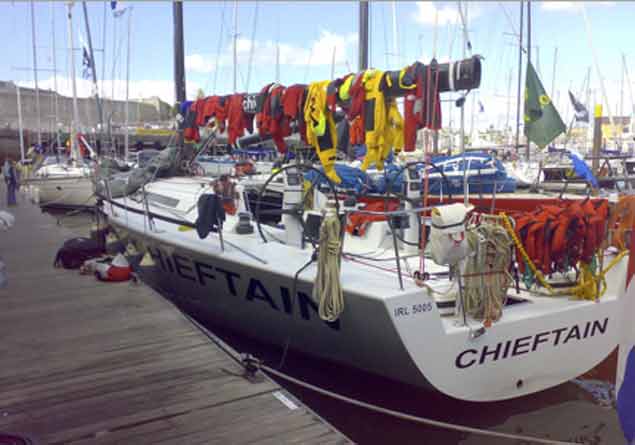 Drying out process….Chieftain in Plymouth after the Rolex Fastnet Race 2007. Photo: Ger O’Rourke
Drying out process….Chieftain in Plymouth after the Rolex Fastnet Race 2007. Photo: Ger O’Rourke
We focused on Chieftain a couple of weeks ago in highlighting her outstanding overall win in the 2007 Fastnet Race to round out an extraordinary global programme, a programme which had seen her win her class and come fourth overall in the 2005 Sydney-Hobart Race, and then place second in the 2007 New York to Hamburg Transatlantic race before going on to sweep the board in the Fastnet of that same year.
That was a sometimes chaotic gale-swept race which was already out of kilter at the start. The RORC fleet was still becoming accustomed to having the Fastnet start on the Sunday at the end of Cowes Week instead of the time-honoured Saturday, yet in 2007 a sudden gale saw its further postponement to the Monday 13th August, so it was right into the next weekend by the time most of the greatly-reduced fleet finished. And though Chieftain had finished late on the Thursday evening to take the win, the exhausted skipper had his work cut out getting his crew kitted out in clean white shirts for the prize-giving on the Friday.
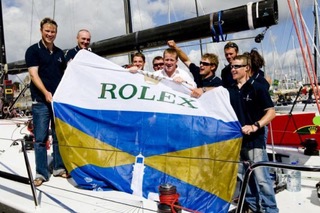 Magic moment – Chieftain’s crew – with Ger O’Rourke at centre – after they’d been told in Plymouth they were overall winners of the Rolex Fasten Race 2007. Photo courtesy Ger O’Rourke
Magic moment – Chieftain’s crew – with Ger O’Rourke at centre – after they’d been told in Plymouth they were overall winners of the Rolex Fasten Race 2007. Photo courtesy Ger O’Rourke
Ger has been through the mill more than somewhat since, as he had the misfortune to break his back in a kite-surfing accident in South Africa and spent a year out of action mending up after open-spine surgery. But he was in a fine nostalgic form when phoning out of Lockdown the other day, and sent on some photos of that Day of Days in Plymouth and the full names of his diverse international crew, who were Ger O’Rourke (IRL) skipper, Jochem Visser (NED) navigator, Dee O’Rourke (IRL) pit, Edwin O’Connor (IRL) Trim, Ryan Houston (NZ) Drive, Cam Marshall (NZ) Bow, Matthew Stuart (NZ) Trim, Tom Whelan (IRL) Trim, Robert Gullan (UK) Mid-bow, Donie Hegarty (IRL) Trim, Kevin Johnson (IRL) Trim, and Tom Whitburn (UK) Pit.
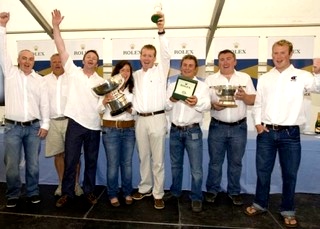 New white shirts all round – crewmember Dee O’Rourke and her skipper father Ger in the middle of Cheftain’s crew at the Rolex 2007 Fastnet Prizegiving
New white shirts all round – crewmember Dee O’Rourke and her skipper father Ger in the middle of Cheftain’s crew at the Rolex 2007 Fastnet Prizegiving
International they may be, but Ger’s roots in Limerick are so strong that he even has a link to the Limerick ketch Ilen, as Gary Mac Mahon of Ilen reckons it was he who introduced the hyper-energetic young Ger O’Rourke to sailing. Back in the 1980s, Willie Sexton’s bar on Henry Street in Limerick was where all the movers and shakers met on a Thursday night, and Gary mentioned in Sexton’s during a typical early-summer Thursday night that the following evening he was off to do a weekend boat delivery under sail, and Ger O’Rourke overheard that and said that he’d be interested in giving this sailing a try for the first time and…….well, history can take it from there.
In the case of Imp, the wild card recognition is because anything to do with George Radley and boats has a streak of wild card brilliance about it. George is a cradle sailor, yet his approach to sailing is sui generis, and the rest of the world can only wonder at what he’ll do next.
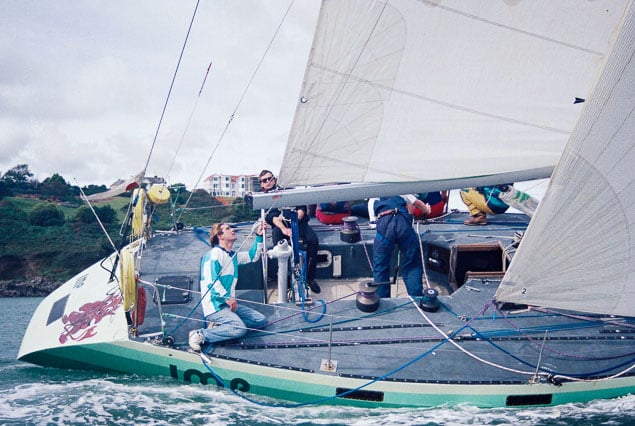 Doing it his way. George Radley at the helm of Imp Photo: Bob Bateman
Doing it his way. George Radley at the helm of Imp Photo: Bob Bateman
But in the case of Cavatina, the wild card is found firstly in the reality that although there were maybe about three dozen Granada 38s built between 1979 and 1983, Cavatina seems to be the only one which has been consistently campaigned offshore under the IRC rule, and she has been doing it with great success since before the turn of the Century.
In fact, her rating has seemed so favourable that when RORC measurer Mike Urwin was at Cork Week one year, he was asked to run the tapes over Cavatina to find out what was the secret ingredient. He reported back that there was no secret ingredient, she just happened to fit the rule very neatly, and maybe the secret ingredient was that her crew happened to sail Cavatina very well in offshore races of adult length.
 A very normal-looking superstar….Eric Lisson’s Cavatina on her way to winning the Round Ireland Race 2006. Photo: Round Ireland/David Branigan
A very normal-looking superstar….Eric Lisson’s Cavatina on her way to winning the Round Ireland Race 2006. Photo: Round Ireland/David Branigan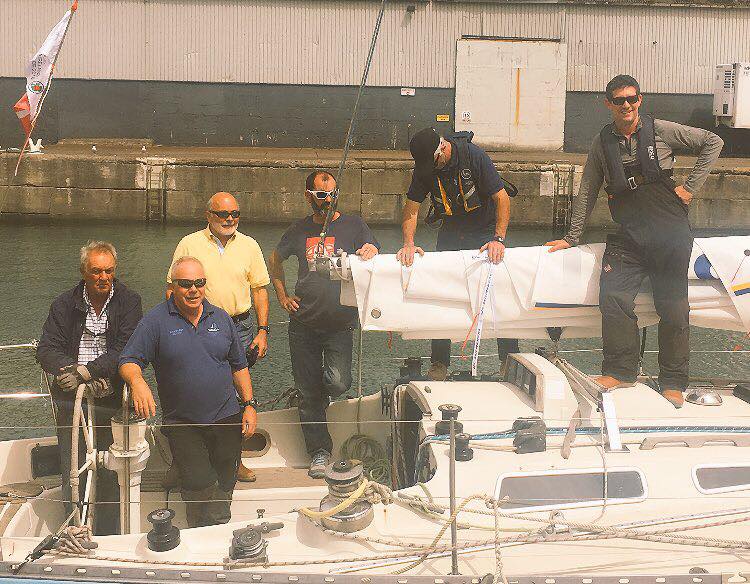 Boat and crew as one – the Cavatina team in Wicklow, scene of some of their major successes
Boat and crew as one – the Cavatina team in Wicklow, scene of some of their major successes
There’s probably a doctoral thesis to be written about Cavatina and her crew, who seem to have remained remarkably consistent in their makeup over the years under the ownership first of Eric Lisson, and more recently of Ian Hickey. Boat and crew, they know each other inside out, such that in any set of circumstances everyone will know what sail combination should be set in order to maximize performance, and they can often seem to communicate this knowledge through a sort of telepathy.
Thus they’re always seen as a threat by others in the Round Ireland Race when they’ve come from behind more than once to take the overall win, they’ve had at least two excellent Fastnets with second overall in 2005’s race and their class win in 2007 when Chieftain took the top prize, and before that in the same year, Eric Lisson and Dave Hennessy brought Cavatina the two-handed division and overall win in the Azores & Back Race.
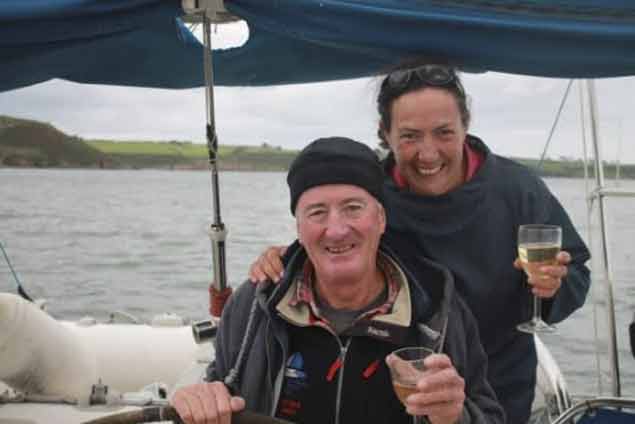 Global circumnavigators – Dave Hennessy and his wife Katrina Emtage on Laragh
Global circumnavigators – Dave Hennessy and his wife Katrina Emtage on Laragh
Dave has also logged a four-year global circumnavigation with the 1989-built Jeanneau Sun Magic 44 Laragh with his wife Katrina Emtage between 2013 and 2016, and they’ve been back to northwest Spain and the Azores since. On top of that, in shore life he’s a renowned melodeon player on the traditional music scene in Cork and beyond. In fact, he seems to achieve so much that you feel inclined to enquire of your usually reliable Cork sources if they’re sure we’re talking about one and the same Dave Hennessy around boats and music, and they’ll enigmatically reply they’ve often wondered the same themselves, but it seems he is just the one person, and here he is with melodeon and friends on YouTube
Meanwhile, we look at the Covid-19 Exit Programme, and wonder why - as the Government has taken such extensive powers to itself - they didn’t simply de-commission today’s Bank Holiday, and keep it in reserve for deployment at a time when people like those who sail Imp and Cavatina can make better use of it…
ISORA Aiming for Full 2020 Offshore Series, Revised Calendar is Published (Download below)
Although ISORA has announced a further postponement of its May fixtures, the ambitious offshore sailing body has also published a revised calendar for the rest of the season (downloadable below) as it commits to running a full programme this season on the Irish Sea and, as Afloat reported previously, it proposes a start date of 31st July for the 160-mile Dublin Bay to Cork Harbour Race.
The first two coastal races have already been postponed and the flags were raised yesterday to announce the postponement of Race 3 and Race 4 - these were the first two offshore qualifying races from Dun Laoghaire to Holyhead scheduled for 2nd May and the Conwy to Dun Laoghaire on 23rd May.
Looking at reshaping the 2020 series ISORA Chairman Peter Ryan said 'we are committed to running a full series in 2020 by providing the offshore racing requested by competitors. To achieve this, we will continue to listen to suggestions and consider all options. We will introduce all of the cutting-edge technologies to achieve this'
"ISORA is very flexible and we will react quickly when there is clarity in what will be allowed"
He also said: 'There is, however, a lot of speculation about when the lock-down restrictions will be eased or lifted, what form of social distancing will be imposed and for how long these will last. We then need to consider the impact these restrictions will have on sailing and offshore racing. We are, of course, reliant on the advice given by our National Governing Bodies RYA & IS. Whilst considering options the safety of our competitor and those who support us is of paramount importance'.
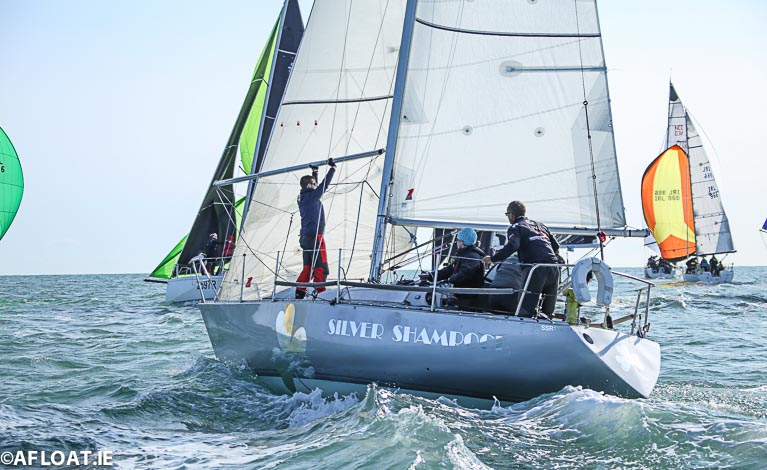 Conor Fogerty's 'Silver Shamrock' at the start of an ISORA coastal race on Dublin Bay Photo: Afloat
Conor Fogerty's 'Silver Shamrock' at the start of an ISORA coastal race on Dublin Bay Photo: Afloat
ISORA does, however, have the ability to be very flexible in setting a revised programme and will react very quickly when there is clarity in what will be allowed.
 The ISORA Committee met to agree a revised calendar via the Zoom platform: Screenshot courtesy ISORA
The ISORA Committee met to agree a revised calendar via the Zoom platform: Screenshot courtesy ISORA
We have looked at a number of options in what may be a very crowded calendar for late summer and autumn.
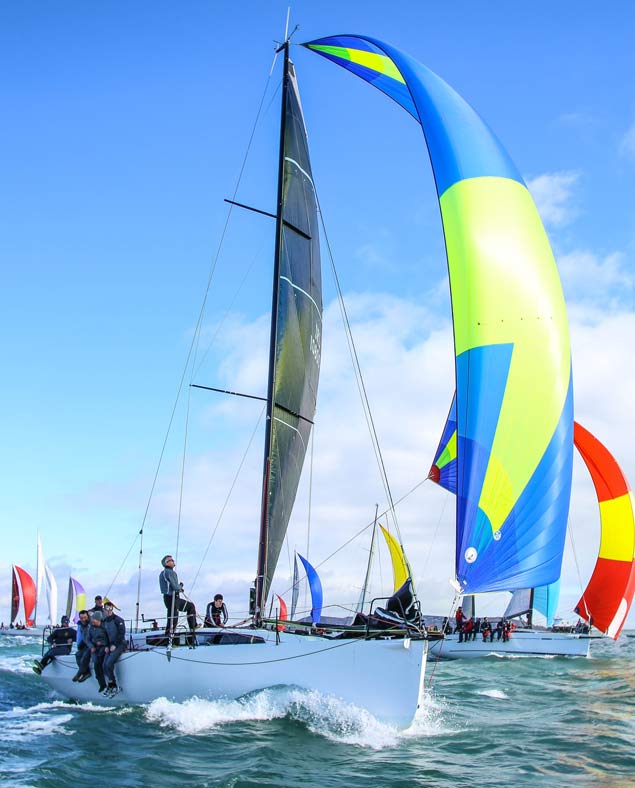 Reigning ISORA Champion Rockabill VI (Paul O'Higgins) of the Royal Irish Yacht Club Photo: Afloat
Reigning ISORA Champion Rockabill VI (Paul O'Higgins) of the Royal Irish Yacht Club Photo: Afloat
In considering options we are conscious that ISORA has always provided the races required to qualify for the Round Ireland Race (new date August 22nd) and we hope to provide this again this year.
Ryan says 'we also want to support other established Championships and Regattas, such as the Wave Regatta 11th - 13th September and the IRC Welsh National Championship 14th to 16th August. The ISORA-organised 160-mile Dublin Bay to Cork Harbour Race is also in the mix with a proposed start date of 31st July'
The document downloadable below sets out the latest proposal for the revised 2020 ISORA Series.
New Date for Dublin Bay-Cork Harbour Race Brings Back Memories of Legendary Schooner America
The postponed date of Friday, July 31st is being considered as a feasible time to think of starting the ISORA-organised 160-mile Dublin Bay to Cork Harbour Race, which was originally planned for July 9th to link this summer’s celebration of the 150th Anniversary of Dun Laoghaire’s National Yacht Club with the massive Tricentenary Celebrations of the Royal Cork Yacht Club.
The COVID-19 lock-down and its aftermath may have wiped out or changed much of 2020’s keenly-anticipated major fixtures, with the SSE Renewables Round Ireland Race on 20th June from Wicklow postponed to August 22nd, while all the main Royal Cork regatta and championship events for July have been cancelled.
But now that the analyses of the disease and its treatment and progress are developing positively on a daily business, it has become a question of “when” rather than “if” on whether or not there can be a meaningful start of the 2020 sailing programme in the best of the summer months, while still adhering to nationwide health guidelines.
A port-to-port offshore race by its very nature involves much less shoreside infrastructure than a major regatta, and Dun Laoghaire’s Peter Ryan of the Irish Sea Offshore Racing Association, a key player in its renewed vitality in recent years, reckons ISORA can thus play a leading role in getting sailing going again, as the Association operates flexibly, and may even offer the slight possibility of a couple of shorter races earlier in July.
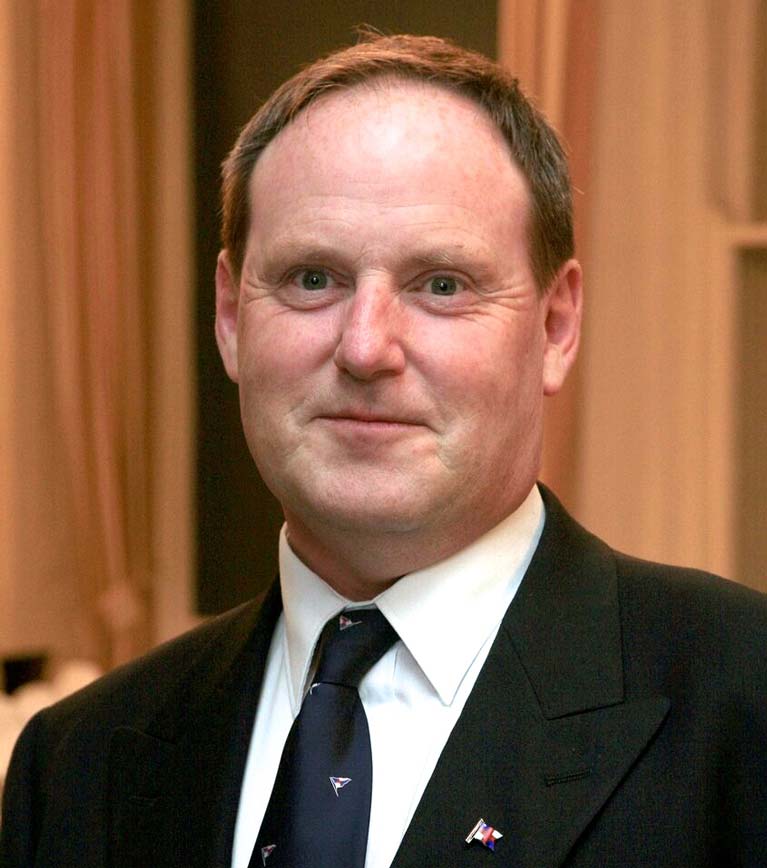 In addition to his successful longtime involvement with ISORA, Peter Ryan was Commodore of the National Yacht Club when it won the Mitsubishi Motors Sailing Club of the Year Award for 2011.
In addition to his successful longtime involvement with ISORA, Peter Ryan was Commodore of the National Yacht Club when it won the Mitsubishi Motors Sailing Club of the Year Award for 2011.
Talking to Sailing on Saturday late this week, while Peter Ryan emphasised that his thoughts were speculative and entirely his own, he reckoned that thinking in terms of starting what would have been ISORA’s big one in 2020, the historic re-sailing of the path-finding 1860 offshore race from Dublin Bay to Cork, could be on the cards by Friday, July 31st.
“It gives a modern connection to such an extraordinarily historic event that running it would cheer everyone up after a period in which we’ve lost so much in so many ways,” says Ryan. “And it would fit in neatly with getting the Irish Sea fleets to Cork to be conveniently on station for the beginning of the four-day Calves Week at Schull on Tuesday, August 4th.
“Then too, it would still leave plenty of time for those who wish to return to the Irish Sea for the Welsh IRC Championship at Pwllheli from August 14th to 16th August. And it would provide a very useful qualifying race for those who need to build up their sea time for the SSE Renewables Round Ireland Race on August 22nd. So everything points to being ready to think in terms of the Dublin Bay to Cork Harbour Race on Friday, July 31st”.
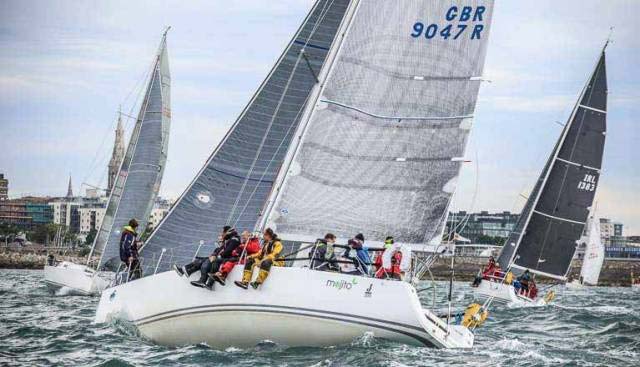 ISORA pre-start manoeuvres off Dun Laoghaire, with the successful Pwllheli-based J/109 Mojito (Peter Dunlop & Vicky Cox) in foreground. With a minimal requirement for shoreside infrastructure and organization, ISORA can be very flexible in modifying its programme. Photo: Afloat.ie/David O’Brien
ISORA pre-start manoeuvres off Dun Laoghaire, with the successful Pwllheli-based J/109 Mojito (Peter Dunlop & Vicky Cox) in foreground. With a minimal requirement for shoreside infrastructure and organization, ISORA can be very flexible in modifying its programme. Photo: Afloat.ie/David O’Brien
This is encouraging stuff, with the reassuring sense of quiet but thoughtful leadership at a time when it’s most needed. That said, the simple basic nature of ISORA’s functioning enables it to be nimble in adapting to changing circumstances. Yet in highlighting the significance of the Dublin Bay to Cork Harbour Race, Ryan definitely is associating his organisation and its revival of the sailing programme with sailing events of exceptional historical significance.
It was June 23rd 1861 when a distinctive 95ft schooner with markedly raked masts slipped into Cork Harbour and came to anchor off Cobh. She’d the look of a vessel which had recently sailed many offshore miles, but her congenial ship’s company were sailing under the burgee of the Royal Victoria Yacht of Ryde on the Isle of Wight, and they flew a well-used British ensign. So despite the absence of a properly-maintained ship’s log, the officials of this naval port accepted the schooner’s bona fides of being on an easygoing family cruise from the Solent to southwest Ireland, and accorded them the privileges which this conferred in terms of the waiving of harbour dues, while the Cobh-based Royal Cork Yacht and Royal Western of Ireland Yacht Clubs both made them welcome.
At the time Cobh – or Queenstown as it then was – was very much the hub of Cork Harbour sailing. For although there was a nascent club across on the western shore at Monkstown, it was 1872 before it became the Royal Munster Yacht Club, while Crosshaven was a tiny fishing port, with one of the few yachts about the place being the Newenham family’s 25-ton cutter Mask, lying to her moorings upriver on the Owenabue River.
 The Sirius Arts Centre in Cobh. Originally the 1854-completed Royal Cork YC clubhouse, it was here that the first Dublin Bay to Cork Harbour Race of 1860 finished, and where the crew of the mysterious schooner Camilla were made welcome on June 23rd 1861.
The Sirius Arts Centre in Cobh. Originally the 1854-completed Royal Cork YC clubhouse, it was here that the first Dublin Bay to Cork Harbour Race of 1860 finished, and where the crew of the mysterious schooner Camilla were made welcome on June 23rd 1861.
But Queenstown was buzzing, for in July 1860 the Royal Cork Yacht Club, under the enthusiastic guidance of its 80-year-old Admiral Thomas G French, had led the way in the inspiration for the first proper offshore race in British and Irish waters. The Royal St George Yacht Club in Dublin Bay had organized a week of regattas in early July, and after they’d concluded, no less than 16 boats – of very varied size and type – had accepted Admiral French’s challenge of racing the 160 miles to Cork, and it started on the 14th July.
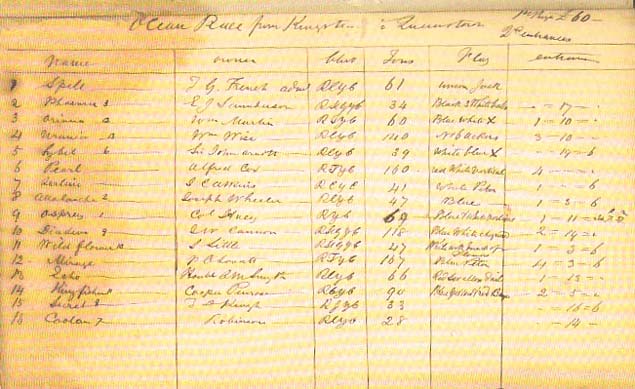 The Entry List for the second race of 1861 was very much an ad hoc affair, with RCYC Admiral Thomas French encouragingly visiting each boat pre-start in Kingstown, and confirming their entry and the fee paid on this list, believed to be written in his own hand. Image courtesy RCYC
The Entry List for the second race of 1861 was very much an ad hoc affair, with RCYC Admiral Thomas French encouragingly visiting each boat pre-start in Kingstown, and confirming their entry and the fee paid on this list, believed to be written in his own hand. Image courtesy RCYC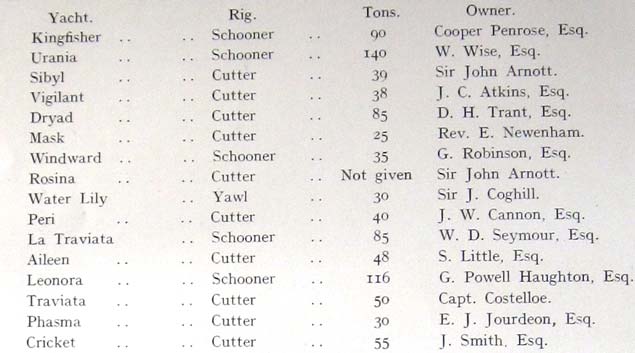 Printed version of the entry list for the first race of 1860 as it appeared in H P F Donegan’s History of Yachting in the South of Ireland, published 1908. Sir John Arnott certainly hedged his bets – he had two entries, and one of them, Sibyl helmed by the amateur Capt. Henry O’Bryen, was the winner
Printed version of the entry list for the first race of 1860 as it appeared in H P F Donegan’s History of Yachting in the South of Ireland, published 1908. Sir John Arnott certainly hedged his bets – he had two entries, and one of them, Sibyl helmed by the amateur Capt. Henry O’Bryen, was the winner
Much of it was raced in rugged windward conditions, but light airs prevailed at the finish off the Cobh waterfront for a real knife-edge conclusion, with Sir John Arnott’s 39-ton cutter Sybil – designed and built on Cork Harbour by Joseph Wheeler of Lower Glanmire – winning line honours and the race by three minutes from J.W.Cannon’s 40-ton cutter Peri, with Cooper Penrose’s 90-ton schooner Kingfisher another two minutes astern of Peri.
Sybil was skippered by the amateur ace Captain Henry O’Bryen, who had reputedly relinquished the helm for a total of only one hour during the race, a triumph for Corinthianism before it had became profitable or popular, if we may mix metaphors for a moment.
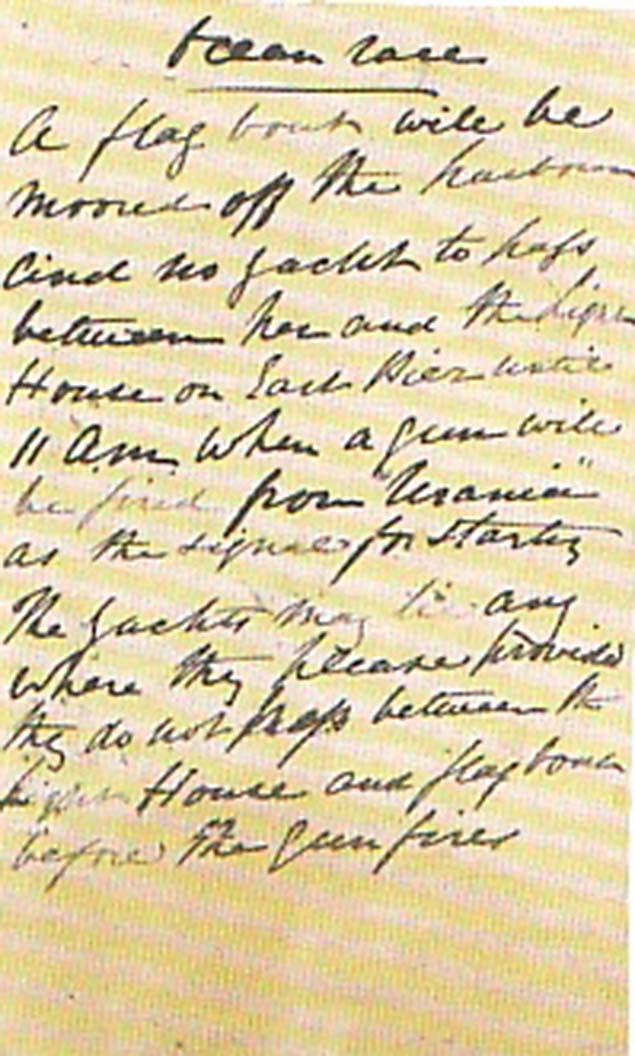 The hand-written Race Instructions for 1860 were also on a “make it up as you go along” basis. It reads: “Ocean Race. A flag boat will be moored off the harbour, and no yacht may pass between her and the Light House on the East Pier until 11 am, when a gun will be fired from “Urania” as the signal for starting. The yachts may lie where they please provided they do not pass between the Light House and flag boat before the gun fires”.
The hand-written Race Instructions for 1860 were also on a “make it up as you go along” basis. It reads: “Ocean Race. A flag boat will be moored off the harbour, and no yacht may pass between her and the Light House on the East Pier until 11 am, when a gun will be fired from “Urania” as the signal for starting. The yachts may lie where they please provided they do not pass between the Light House and flag boat before the gun fires”.
But Sybil’s owner Sir John Arnott (1814-1898) was something else, a real go-getting Scottish-born entrepreneur who’d arrived into Cork in 1837 aged 23 and launched himself into a sometimes rocky commercial career which at various stages involved heavy investment in department stores in Ireland and Scotland, horse racing both as an owner of thoroughbreds and of noted race courses, steamship companies, railways, and for a while the inevitable newspapers, in his case The Northern Whig in Belfast and The Irish Times in Dublin.
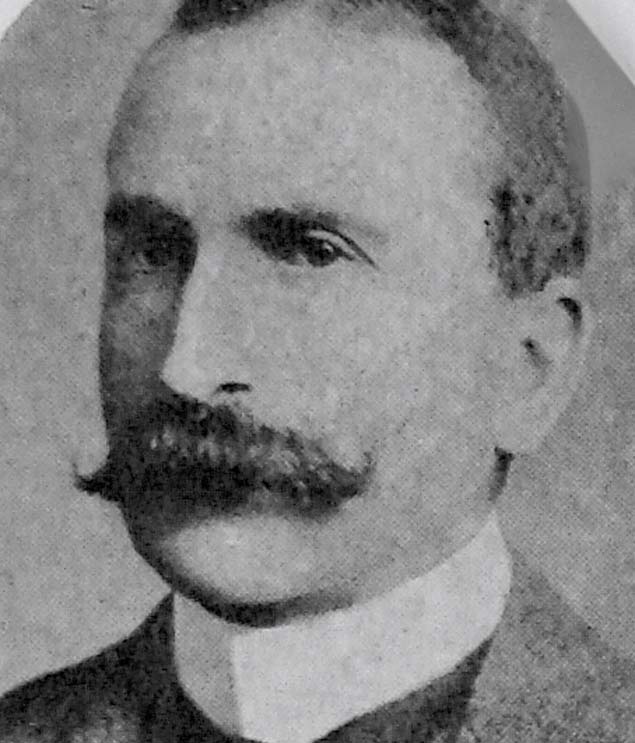 Victorian entrepreneur Sir John Arnott, who had two yachts entered in the first Kingstown to Queenstown Race of 1860
Victorian entrepreneur Sir John Arnott, who had two yachts entered in the first Kingstown to Queenstown Race of 1860
Arnott was always a man in a hurry, so it’s possible that he thought the distinguished flag officers of the Royal Cork were a bit conservative in their management. Thus he was one of a bunch of shaker-uppers who set up a new club in Cobh, the Queenstown Yacht Club, which they cleverly up-graded by taking on the tattered-remains of the old Royal Western of Ireland YC, founded in 1828 in Kilrush by Maurice O’Connell and his nephew Daniel of Derrynane among others, but wandering more or less homeless after the horrors of the Great Famine of 1845-47 had wiped out fripperies like yachting on Ireland’s Atlantic seaboard.
After a vague period in Dublin, suddenly the old Royal Western emerged re-born in 1861 in Cobh with Sir John Arnott as Commodore, and for their first season under this new arrangement, they showed nimbleness of foot by organising - at very short notice - a regatta to provide a race for this strange schooner which had suddenly arrived in their midst.
For although the schooner had the name of Camilla across her shapely transom, the dogs in the street in Queenstown knew that this was the one and only America, the 1851-built New York flyer which, by convincingly winning a rather hastily-assembled race round the Isle of Wight on the final day of Cowes Week 1851, had won a silver cup worth one hundred pounds sterling for her New York Yacht Club syndicate of owners.
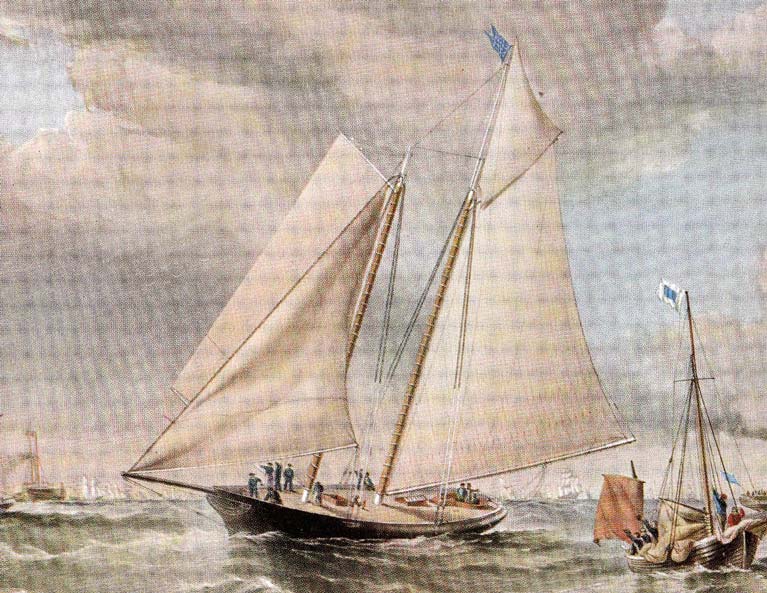 America wins, Friday, August 22nd 1851. Almost everything about her was different, including her notably flat-setting cotton sails, but she was soon being imitated
America wins, Friday, August 22nd 1851. Almost everything about her was different, including her notably flat-setting cotton sails, but she was soon being imitated The poster for Cowes Week 1851. The social pace was so hectic that they only had time for three races, and in the notice for Friday 22nd August, the inclusion of “yachts of the Clubs of all nations” was actually aimed at expected entries from the Imperial Yacht Club of St Petersburg in Russia. They failed to arrive, but in the meantime the schooner America had turned up, though she had to wait through the week until she could finally race on the Friday. From these only semi-planned beginnings, there emerged The America’s Cup.
The poster for Cowes Week 1851. The social pace was so hectic that they only had time for three races, and in the notice for Friday 22nd August, the inclusion of “yachts of the Clubs of all nations” was actually aimed at expected entries from the Imperial Yacht Club of St Petersburg in Russia. They failed to arrive, but in the meantime the schooner America had turned up, though she had to wait through the week until she could finally race on the Friday. From these only semi-planned beginnings, there emerged The America’s Cup.
In 1861 when the schooner was briefly in Cork, this rather unlovely cup – ewer is the technical name - was yet to become known as The America’s Cup, and there wasn’t to be a challenge to take it from the Americans until 1870. But ten years after her famous victory round the Isle of Wight, the myth and mystique of the schooner America was well established as part of world sailing lore, and the Young Turks in Cork sailing associated with John Arnott made the most of it, with this special schooner race quickly organised by the Royal Western of Ireland for June 28th, Camilla/America’s opposition being W D Seymour’s 85-ton La Traviata, W Wyse’s 140-ton Urania, and C H Smith’s “little” 66-ton Echo.
Camilla/America’s sails were tired and so were her crew, yet she still managed to take line honours in this slightly mysterious race. But it was by only one minute from the much-smaller La Traviata, which had been amateur-helmed by W D Seymour’s son to a clear handicap victory. After the finish, young Seymour was borne ashore shoulder-high by the cheering waterfront crowds to achieve a Cork Harbour sailing and sporting eminence to match that of Henry O’Bryen who – in a shrewd bit of window-dressing worthy of Arnott’s at their best - had been drafted in as Vice Commodore of the Royal Western of Ireland.
However, all these seemingly-rebellious Young Turks in the re-born RWIYC had retained their membership of the Royal Cork YC and would in time become part of its establishment lineup. But if they’d hoped to promote their “new” club by persuading the Camilla/America to take part in 1861’s staging of the Kingstown to Queenstown Race, they were disappointed, for as we shall see, the famous schooner had serious business elsewhere, and was soon gone.
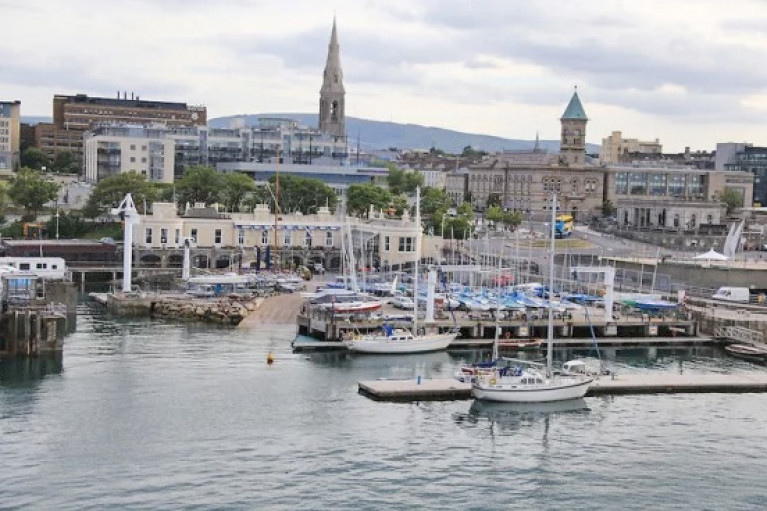 The Royal St George Yacht Club hosted the start of the first Dublin Bay to Cork Harbour race in 1860. Photo: Afloat.ie/David O’Brien
The Royal St George Yacht Club hosted the start of the first Dublin Bay to Cork Harbour race in 1860. Photo: Afloat.ie/David O’Brien
As it is, the 1861 race was started in Dublin Bay on 19th July, and once again mustered 16 starters with the winner being Colonel Huey’s slippy 62-ton cutter Osprey, with designer-builder Joseph Wheeler’s own 48-tonner Avalanche having to make do with second despite having led into Cork Harbour in light airs, while E J Saunderson of Lough Erne YC was third with another even smaller and slippy craft, the 34-ton cutter Phasma.
Admiral French’s own 61-ton yawl Spell took part this time (see first name on written entry list above), but although he was to continue as RCYC Admiral until his death in 1866, he’d already been 77 when he took over as Admiral in 1857, and his enthusiastic promotion of the Kingstown-Queenstown race’s first staging in 1860 suggested an old man in a hurry to promote an idea which he’d been carrying for some time.
Certainly, at its third staging on July 11th 1862, there’s a clear impression that others had taken it over, as the host club on Dublin Bay has become the Royal Irish YC from their impressive 1851-completed clubhouse, while the trophy is an expensive bit of silver plate presented by the Royal Western YC.
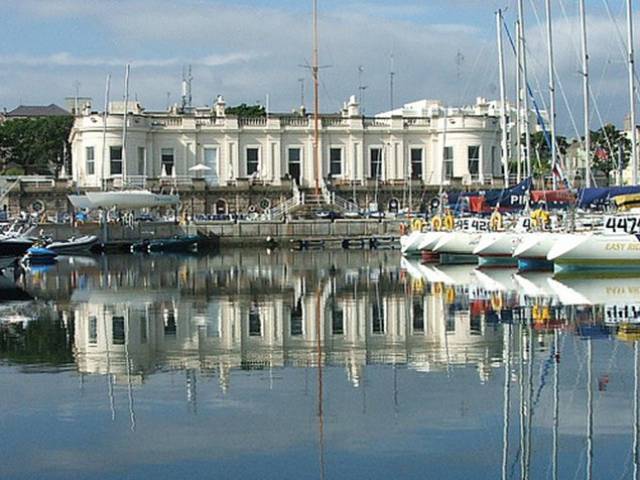 The Royal Irish Yacht Club hosted the start of the third and final Kingstown to Queenstown Race in 1862
The Royal Irish Yacht Club hosted the start of the third and final Kingstown to Queenstown Race in 1862
For anyone seeking abstruse historical connections, it’s of interest that The Liberator, Daniel O’Connell of Derrynane (1775-1847) had been present at both the foundation of the Royal Western in Kilrush in 1828, and the meeting in Dublin on July 4th 1846 when the 1831-founded Royal Irish YC had been revived. Meanwhile, in 1862, the Kingstown-Queenstown Race once again attracted 16 starters (though there’s no note of any entry limit), and they ranged in size from three 35-ton cutters – Ariadne (G Higgins), Coolan (G Robinson) and Glance (A Duncan – to two 130-ton schooner, Galatea (T Broadwood) and Georgiana (Capt Smith Barry).
The clear winner was the 50-ton cutter Phosphorous owned by W Turner - who is doubtless immortalized in modern Cork by Turner’s Cross - while C J Tennant’s 90-ton cutter Clutha was second on the water, but Galatea won the schooners and was reckoned second on handicap.
They arrived into the finish at Cobh where the Royal Western of Ireland was now well-established as the second club with premises at Westbourne Place next the Queen’s Hotel, and a membership which by 1863 included the Lord Lieutenant, Lord Carlisle, as well as Sir Robert Peel, at that time Chief Secretary for Ireland. So heaven only knows what politicking was going on behind the scenes, for the Royal Cork, still with T G French as Admiral, had been well settled into its purpose-designed new clubhouse (now the Sirius Arts Centre in Cobh) since 1854, and no-one doubted its claim of seniority in its descent from the Water Club of 1720.
As it happened, 1863 was probably the high point of the RWIYC’s time in Cobh, for the rest of the decade saw a period of economic decline, and the Dublin Bay to Cork Harbour Race wasn’t staged again. While the Royal Cork came through the thin times as it had come through many others, in 1870 the Royal Western of Ireland YC was quietly wound up at Cobh. But in the west of Ireland, and particularly with the Glynn family of Kilrush and The Knight of Glin across the Shannon Estuary, enough of its memorabilia, artefacts and records survived for it to be revived with the opening of Kilrush Marina, with the club’s greatest modern success being Ger O’Rourke’s overall victory with the Cookson 50 Chieftain in the RORC Rolex Fastnet Race 2007.
This may all seem to be something of an impenetrable maze of history, but it’s perfectly straightforward by comparison with the story of the schooner America, and how she came to be in Cork.
Everyone knows that she was hurriedly built early in 1851 in New York by Brown’s Shipyard, to the designs of the 31-year-old George Steers, for a swashbuckling syndicate of New York Yacht Club members led by John Cox Stevens. The project was to send a challenger across the Atlantic to race the English in Cowes Week at a time when the Great Exhibition in London was signalling the global achievements of the British Empire and its worldwide commercial success and dominance.
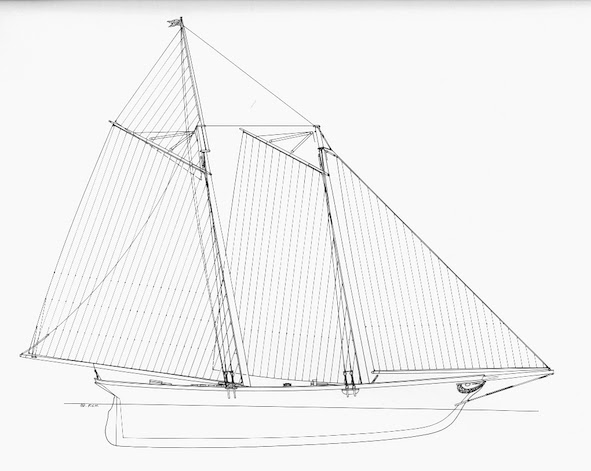 America as she was rigged when she won on August 22nd 1851. The boom on the jib broke during the race, which lost her about 15 minutes in repairs, but she was still well ahead at the finish.
America as she was rigged when she won on August 22nd 1851. The boom on the jib broke during the race, which lost her about 15 minutes in repairs, but she was still well ahead at the finish.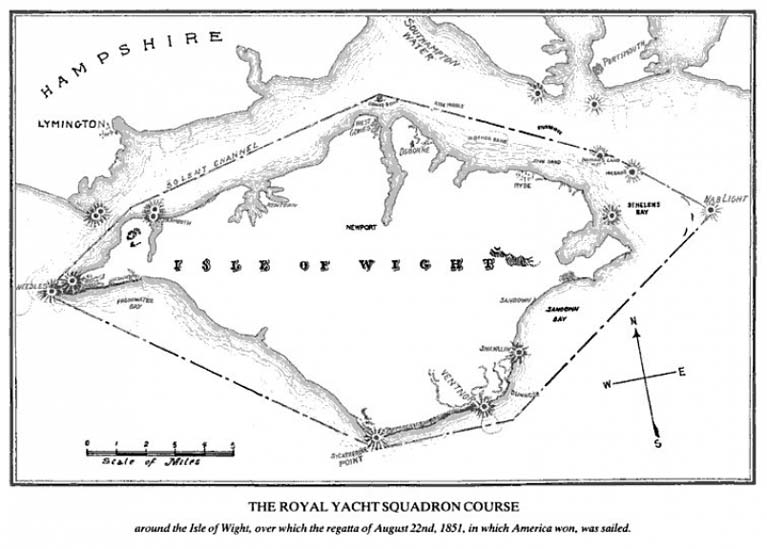 The 57-mile course for August 22nd 1851 – the Isle of Wight was rounded clockwise
The 57-mile course for August 22nd 1851 – the Isle of Wight was rounded clockwise
Not one of the top British racing yachts looked remotely like America, with her low rig and its raked masts, and her extremely hollow waterlines forward. But after she’d made her mark in a very distinctive fashion in just one race round the Isle of Wight on Friday, August 22nd 1851, several English racers were very expensively altered to take on board some of her ideas.
As for her American owners, they were gamblers to a man, so they collected their winnings, and celebrated mightily in New York, supported by their fellow-citizens to such an extent that grinchy Manhattan lawyer George Templeton Strong confided to his diary: “Newspapers crowing over the victory of Stevens’s yacht, which has beaten everything in the British seas. Quite creditable to Yankee shipbuilding, certainly, but not worth the intolerable, vainglorious vaporings that make every newspaper I take up now ridiculous. One would think yacht building were the end of man’s existence on earth”.
Quite so. Henry James would have been pleased with that. But as for America’s owners, they dropped ideas of sailing her home, and sold her in the Solent for 25,000 dollars to an Irish army officer of French Huguenot extraction, John de Blaquiere, who was soon to become the fourth Baron de Blaquiere of Ardkill in County Derry, where the family had thousands of acres acquired through their skills in tax gathering for the government, while the title came from supporting the Act of Union in 1801.
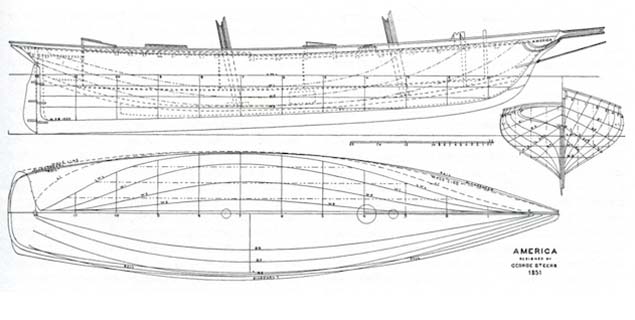 An amazingly well-balanced hull, with a rudder more like a trim tab. In her original form, America was steered by a small tiller, and the fact that her rudder stock had a very small rake forward may have helped her lightness of helm
An amazingly well-balanced hull, with a rudder more like a trim tab. In her original form, America was steered by a small tiller, and the fact that her rudder stock had a very small rake forward may have helped her lightness of helm
Despite these links, de Blaquiere never brought America to Ireland, but did some remarkable cruising to the Mediterranean, with the famous racing boat demonstrating her seagoing credentials by coming through a very severe storm off Malta in February 1852, while her legendary lightness of helm was eulogised by an experienced guest sailor: “Many yachtsmen will remember the almost mop-handle diminutiveness of her tiller, I steered her when going seven knots close-hauled and in some Bay of Naples swell, standing to leeward of the tiller and pressing against it with my little finger only”.
America’s hull was so sweetly balanced that her slim rudder was little more than a trim tab, but it was a trim tab made as effective as possible by being so vertical that the stock is almost inclined forward, unlike the unhealthy measurement-rule induced rudders of a later era, with their excessive and inefficient aft-raking of the stock.
Yet with all her virtues, as John Rousmaniere has commented in “The Low Black Schooner”, his brilliantly succinct account of this remarkable vessel, in the mid-1850s: “America was neglected because she had succeeded to the ambiguous status that is reserved for all trend-setters past their time.” However, in 1856 she was bought by yet another Irish peer from the north, this time Lord Templeton whose lands were in County Antrim, but he never brought America to Ireland either. In fact, he scarcely used her, though he did re-name her Camilla, and it was under this name that she was sold to ship-builder Henry Pitcher, who did extensive re-build work at his yard on the Thames.
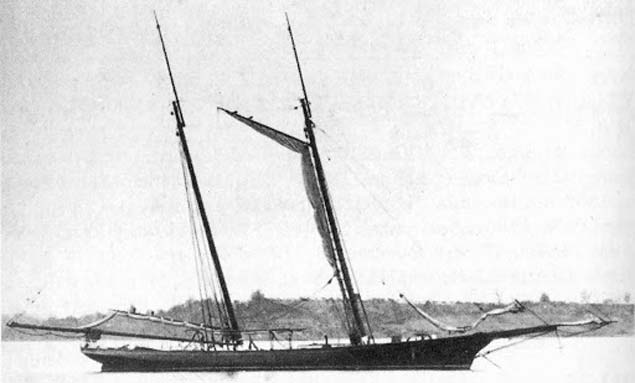 America’s rig underwent various forms in later life, and at one stage she had topmasts on both the main and fore masts, with the mainsail and the boomless foresail brailed up to their gaffs, the foresail’s gaff boom being left aloft. A retractable addition was also fitted to the bowsprit.
America’s rig underwent various forms in later life, and at one stage she had topmasts on both the main and fore masts, with the mainsail and the boomless foresail brailed up to their gaffs, the foresail’s gaff boom being left aloft. A retractable addition was also fitted to the bowsprit.
He then sold her in 1860 to a “mysterious character” called Henry Edward Decie, supposedly a 28-year-old former officer in the Royal Navy, where they’d been obliged to let him go, as they say in HR circles, because he’d been excessively zealous in chasing pirates on the coast of South America, and had knocked lumps out of a Brazilian warship by mistake.
Maybe so. At least that was his story, but we’re into murky waters here, and things were becoming even murkier in the USA with the Civil War looming. A dodgy character like Decie with a super-fast boat like Camilla ex-America - with her proven transatlantic capacity - was just what the Confederate States were looking for in assembling a fleet of fast blockade runners.
Henry Decie seems to have been Captain Cool, and he certainly loved sailing. Family cruising too. In August 1860, having won a race in a regatta at Plymouth, Camilla sailed away with Henry Decie and his wife or maybe she was his mistress and her six children and a crew of thirteen (nothing superstitious about our Henry), and after calling at several places including Lisbon and the Cape Verde Islands, on April 21st 1861 she fetched up on the other side of the Atlantic at Savannah, Georgia. There, the rebel Confederate Government had her bought within a month for 60,000 dollars on condition that Decie remained in charge, and undertook a voyage to Europe with a mission to purchase armaments and organize the building of warships.
So the former schooner America set off back to Europe still under the command of Henry Decie on the 25th May 1861 for her third Atlantic crossing, and on board with Decie and his shipmates were two Confederate Agents with Bills of Exchange to the tune of 600,000 dollars, plus Letters of Credit for much more. This was serious stuff. Yet on June 23rd it was as a light-hearted cruising vessel that she arrived into Cork Harbour, claiming the immunity and privileges conferred by her Royal Victoria Yacht Club burgee and British ensign, with Decie saying that he’d just strolled over from Cowes for a little competition.
 The modern port of Savannah in Georgia, USA. The schooner Camilla ex-America departed Transatlantic from here on 25th May 1861, but when she arrived in Cork Harbour on June 23rd, her skipper Henry Decie claimed they’d just sailed over from Cowes.
The modern port of Savannah in Georgia, USA. The schooner Camilla ex-America departed Transatlantic from here on 25th May 1861, but when she arrived in Cork Harbour on June 23rd, her skipper Henry Decie claimed they’d just sailed over from Cowes.
That was duly arranged in jig time by the Royal Western Yacht Club of Ireland in Cobh. We can only guess as to who really knew what was going on. The two Confederate agents soon disappeared into the bustle ashore and onward on their mission, and Henry Decie and the Cork Harbour schooners went yachting, but then he had to depart again within a day or to rendezvous with the agents.
In time, Camilla reverted to being America, and she finished the Civil War serving on the Union side. In various ownerships and eventually, in the charge of the US Navy, she survived until 1945. But the 100,000 dollars which President Franklin D Roosevelt had allocated for the maintenance of the old girl never reached her in the hectic end-of-war period, and in 1945 the roof of the shed she was housed in collapsed under a freak fall of snow, and that was the end of the wonderboat of 1851 which had briefly been a sensation when she sailed into Cork Harbour in 1861.
Jack Bouttell & Alexis Loison Interview
RORC's Louay Habib is joined by Jack Bouttell and Alexis Loison who talk through sailing some of the biggest races in the world.
Jack Bouttell started racing with the RORC on Piet Vroon's Tonnerre as a teenage bowman and just eight years later he was lifting the Volvo Ocean Race Trophy with Dongfeng Race Team. Achievements also include three Figaro campaigns, including Rookie of the year, and racing with Team Concise on both the Class40 and the MOD70. Jack is still under 30 and now lives in L'Orient, France and is part of the Spindrift Jules Verne Challenge.
Alexis Loison shot to fame winning the 2013 Rolex Fastnet Race overall, racing with his father on Night and Day. Pascal and Alexis Loison became the first and only Two-Handed team to lift the Fastnet Challenge Cup. Alexis was part of Géry Trentesaux's Courrier Recommandé - overall winner of the 2018 Rolex Middle Sea Race, and won class in the 2015 Rolex Sydney Hobart racing Géry's Courrier Leon. Alexis Loison is now set for his 15th Solitaire du Figaro with Region Normandie.
If we needed a reminder of the central role which the biennial Round Ireland Yacht Race from Wicklow has grown into within Irish sailing and in the global offshore racing context during its 40 years and 20 editions, then the ramifications of its postponement from the 20th June 2020 to the 22nd August is really all that is required to signal the importance of this 704-mile challenge.
In the very complete Coronavirus COVID-19 meltdown of normal life, the numbers of sailors and others advocating such a move – or something similar - had been steadily increasing, as it became increasingly evident that the date was still available and possible, yet needed to be booked well in advance. As the time needed for the countrywide eradication of the disease is still very much an unknown - despite increasingly sophisticated analyses of its progress – the latest possible date for the race while still placing it within the summer season was the one which had to be chosen.
The sympathies of any reasonable person and all experienced sailors – particularly the large numbers who have raced in this very special event – will have been very much with Wicklow SC Commodore Kyran O’Grady and his organising team, together with their new, supportive and understanding sponsors in SSE Renewables, as they grappled with a challenging decision.
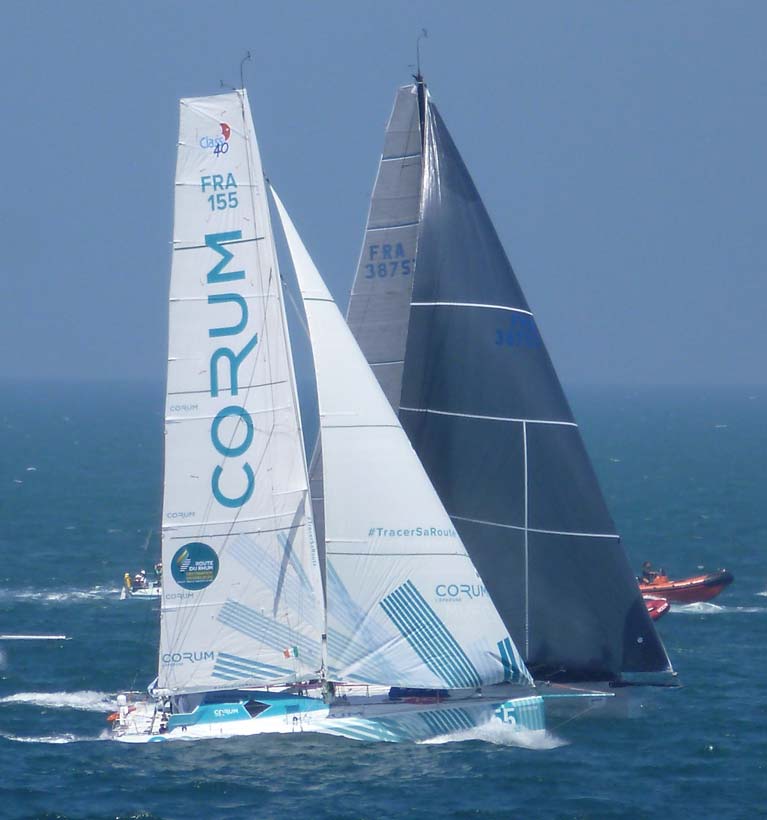 The modern Round Ireland Race has international credentials – France’s Corum and Teasing Machine battle it out at 2018’s start. Photo: W M Nixon
The modern Round Ireland Race has international credentials – France’s Corum and Teasing Machine battle it out at 2018’s start. Photo: W M Nixon
An event of this stature has a dominant position in the entire complex season-long structure of the Irish sailing programme. Thus, even when it had to be postponed by only one week to June 30th in 2018, the rest of the national cruiser-racer schedule in that period of the summer adjusted itself accordingly.
But that was a minor change by comparison with this new two months hiatus during which – if the lock-down is so successful that it can start to be significantly eased – we can expect pop-up regattas and immediate sailing events to be rapidly organised in the best flash mob-style the instant sailing becomes possible again.
In the crazy times we live in, and with everyone probably slightly off their rockers by the time we do get sailing again, it’s perfectly possible that folk will get a taste for this sort of ad hoc arrangement, and a long countdown event like the Round Ireland will seem almost quaint.
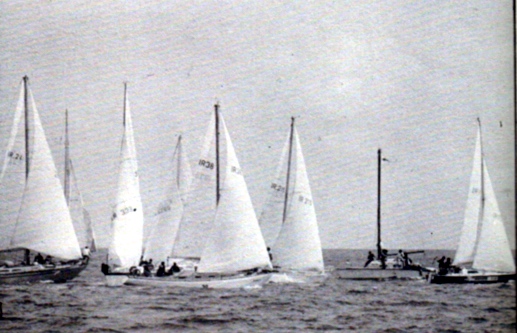 Small beginnings – the start of the first Round Ireland Race off Wicklow in 1980. The winner was Brian Coad’s Rival 34 Raasay of Melfort (centre) from Dunmore East. Photo: W M Nixon
Small beginnings – the start of the first Round Ireland Race off Wicklow in 1980. The winner was Brian Coad’s Rival 34 Raasay of Melfort (centre) from Dunmore East. Photo: W M Nixon
But by its very nature, the Round Ireland has to be a long countdown event, for it requires participating crews to have logged a certain amount of minimal experience in serious offshore competition, such that one of the strongest pressure groups in urging a specific postponement was the sailing schools, who reckoned they’d find it very difficult to fulfil their quota of qualifiers in such a truncated early season.
Yet with other potential events starting to wave flags about easily re-shaped happenings which can be put together almost overnight, serious Round Ireland owner-skippers are going to find themselves in a quandary, for although a successful offshore racing crew is not a democracy, nor is it an autocracy. Decisions are reached through a sort of osmosis.
Denis Doyle & Moonduster
In these circumstances, the best approach is to ask: “What would The Doyler have done?” Or rather, “What would The Doyler do?” For although the great Denis Doyle of Cork has been gone from among us now for 19 years - having sailed his last Fastnet Race on the Crosshaven-built Frers 51 Moonduster at the age of 81 in 2001 - his sailing inspiration and moral example is so strong that, for an entire generation of Irish offshore campaigners, it’s The Doyler who continues to be our reference point, our ever-present guide, our moral compass.
 Denis Doyle – he was racing offshore for sixty years
Denis Doyle – he was racing offshore for sixty years
Yet by seeing him as such, we aren’t contravening the great Dwight D Eisenhower’s hallmark of a successful commander, which was revealed here in a fascinating piece about strategy and tactics by that renowned soldier-sailor Commandant Barry Byrne, originally of Wicklow, and no stranger to success in the Round Ireland Race himself.
The word from Commandant Byrne was that Eisenhower was totally supportive of high-level commanders and staff officers who were always planning, but didn’t have some sacred fixed Plan, other than an ultimate objective.
 The J/109 Joker II (John Maybury, skippered by Barry Byrne) at the start of the 2018 race, in which she finished second overall. Photo: Afloat.ie/David O’Brien
The J/109 Joker II (John Maybury, skippered by Barry Byrne) at the start of the 2018 race, in which she finished second overall. Photo: Afloat.ie/David O’Brien
Thus Denis Doyle, who was racing offshore from the late 1930s until just after the turn of the century, was keen to go offshore racing, and even keener if he felt it was good for Cork, good for Ireland, and good for life generally – his ultimate objective was broad in scope.
So although the first Round Ireland Race of 1980 from Wicklow (see the first set of sailing instructions here) was seen by many in the Irish sailing community as a rather cheeky shot in the dark from a small club, Denis Doyle in Cork saw that it was good, and with his new Moonduster built in 1981, he arrived into Wicklow with this marvellous boat for the next race in 1982, and his commitment to the Round Ireland Races thereafter was complete, contributing enormously to its long-standing success.
 “This marvellous boat” – the new Crosshaven-built Frers 51 Moonduster in 1981. Photo: W M Nixon
“This marvellous boat” – the new Crosshaven-built Frers 51 Moonduster in 1981. Photo: W M Nixon
Now admittedly all the Round Ireland Races in which he competed – winning two of them and establishing course records in both 1982 and 1984 – were placed firmly in the final week of June, which thus left the later part of the season clear for other events for Moonduster, events which could be very distant.
For instance, one year he and three others including his ever-supportive wife Mary set out to sail Moonduster post-haste to Sardinia in order to race in the Sardinia Cup. And as well, the elegant varnished sloop was no stranger to the regattas in Galicia in northwest Spain, so much so that when I first ambled into the Monte Real Yacht Club in Bayona after an unusually agreeable Biscay crossing back in 1995, it was to note with interest that the newly-installed board listing Honorary Members was so new it had just two names on it – Denis Doyle and some guy called Juan Carlos.
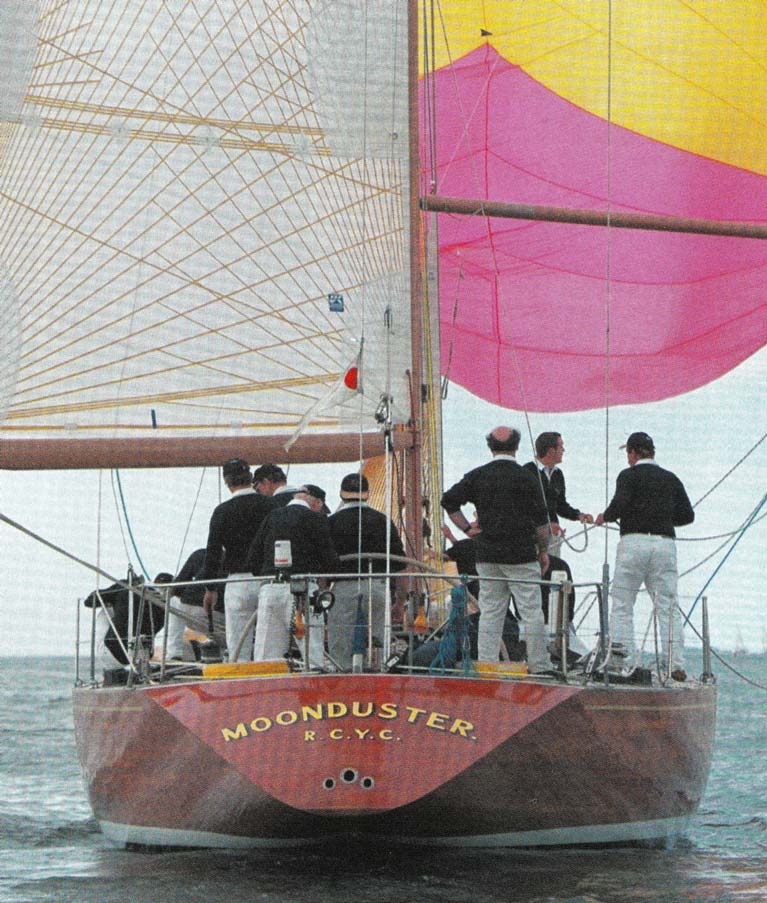 Throughout his 20 years with the Frers-designed Moonduster, Denis Doyle kept her topsides varnished. This is how she looked in 1995, at the start of the Dun Laoghaire-Dingle Race. Photo: David O’Brien/Afloat.ie
Throughout his 20 years with the Frers-designed Moonduster, Denis Doyle kept her topsides varnished. This is how she looked in 1995, at the start of the Dun Laoghaire-Dingle Race. Photo: David O’Brien/Afloat.ie
So his reach in sailing was truly pan-European, yet once he’d given his commitment to some event and its locality, his commitment was maintained through thick and thin, a commitment which remained through major changes when those changes were caused by circumstances beyond the control of the event organisers. So although the Round Ireland Race is now going to be two months late, I think we know what The Doyler would do.
For sure, the nights will be significantly longer and the weather of late August can be verging into the Autumnal. But those longer nights don’t seem quite so brutal as some of the short nights of June, for the sea has become significantly warmer and if the weather is benign, there’s a velvet quality to those longer nights which can make them a pleasantly memorable experience.
But either way – good weather or mixed – we can be sure that if Denis Doyle were still around, any ideas he might have had about other sailing plans for late August would have been scrapped in the exceptional circumstances caused by the COVID-19 outbreak, and first priority would be given to the original commitment of being on the starting line for the Round Ireland Race, even if Force Majeure has caused it to be held two months late.
 The original “white Moonduster”, a 47ft Robert Clark design built in Crosshaven in 1965, making to windward towards the Rock in the Fastnet Race of 1969
The original “white Moonduster”, a 47ft Robert Clark design built in Crosshaven in 1965, making to windward towards the Rock in the Fastnet Race of 1969
He would be there because it’s the right thing to do. This attitude was clearly revealed back in 1972, when Denis Doyle was a flag officer both of the Royal Cork YC and the Royal Ocean Racing Club, and still racing the handsome Robert Clark-designed Crosshaven-built 47ft white Moonduster of 1965 vintage. The core event of the season was one with which he was particularly involved, an RORC Cowes to Cork Race after Cowes Week, something which promised great sport for a large entry.
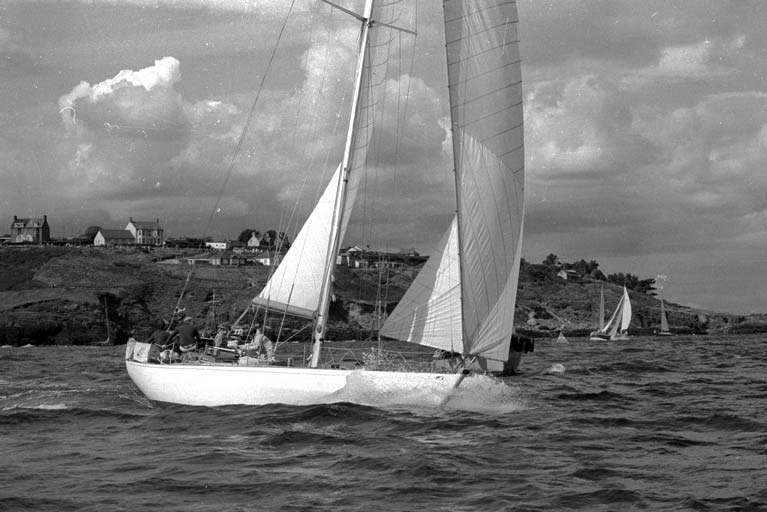 The original Moonduster manoeuvring before the start of the 1970 RORC Cork-Brest Race, after the RORC fleet had raced Cowes-Cork as part of the Royal Cork YC Quarter Millennial celebrations. Photo: W M Nixon
The original Moonduster manoeuvring before the start of the 1970 RORC Cork-Brest Race, after the RORC fleet had raced Cowes-Cork as part of the Royal Cork YC Quarter Millennial celebrations. Photo: W M Nixon
But as 1972 progressed, the Troubles in Northern Ireland deepened rapidly with much bloodshed, and the top management in the RORC became jittery about their fleet racing to “war-torn Ireland”. Denis assured them that nowhere was further and safer from the northern troubles than the race’s destination at the Royal Cork YC in Crosshaven, but he was over-ruled, and the decision was made to race instead from Cowes to Santander in Spain.
Denis took this rebuff in his usual calm way, and entered Moonduster for the 1972 RORC Cowes-Santander Race. As was her wont, Mary Doyle went out to Spain to be ready to welcome her husband and his crew at the finish. And as Moonduster glided up the river, there indeed was Mary, coolly stylish as ever, elegantly waiting beside the smoking ruins of the Real Club Maritimo de Santander. It had been blown up by Basque Separatists the night before.
North Sails Ireland: How to Remain Focused Racing Offshore
Offshore Sailing Guru Casey Smith shares his thoughts on how to remain focussed during long periods at sea in this latest North Sails article. When we get back to racing later in the season this could be really helpful for all of the ISORA and Round Ireland racers looking to up their game.
Day after day, mile after mile, distance racing reminds us of that never-ending feeling of being stuck in one place for extended periods of time. Hear more from Casey Smith (CS) how to cope with those long periods of isolation where you can only do so much. Casey is a two-time Volvo Ocean Race veteran and was a key member onboard during all of Comanche’s record runs and race wins. Casey knows a lot about being stuck out at sea, but still finds humour in the little things and gets his job done, which is most important.
We hope you enjoy the read here
Round Ireland Yacht Race Record Entry in Prospect?
Coronavirus may have postponed tonight's official launch party but there's no stopping interest in June's SSE Renewables Round Ireland offshore race that gets underway in 14 weeks time.
The prospect of some potent international entries into this year's race is adding extra spice to an already a bullish entry for the 21st edition.
The 2020 race from Wicklow Sailing Club is already being billed as a potential 'record' one by organisers and that's quite an achievement given the year's packed offshore fixture list.
The much-rumoured entry of the French offshore great Teasing Machine plus the entry of a JPK 10.30, according to an Afloat source. has the potential to make this a very special international race indeed.
Launched in July 2017 with success in the 2017 Rolex Middle Sea Race, as its class winner and third overall, Owner Eric de Turckheim's Teasing Machine is a well blooded offshore racer having also competed in the Sydney-Hobart race.
 A new JPK 10.30 design could be on the cards for June's Round Ireland Race Photo: Carlo Borlenghi/Rolex
A new JPK 10.30 design could be on the cards for June's Round Ireland Race Photo: Carlo Borlenghi/Rolex
The solid take-up defies early fears that the race might have struggled with other key fixtures such as early July's Kingstown to Queenstown Race and the Morgan Cup from Cowes to Cork Week.
Entries received to date include Malta, UK, USA, Scotland, Wales, Isle of Man, France, Germany and Ireland while the race is a starred event in the Royal Ocean Racing Club's calendar meaning more overseas entries are likely. The largest entry is the 21m Neptune 3 from Malta skippered by Greg Miller. She will be joined on the start line by former Round the World boat 70-footer Telefonica Black under Lance Shepard from the UK.
Round Ireland is the second longest race in the Royal Ocean Racing Club calendar and first race took place in 1980 with only thirteen boats. Since then, held biennially, the fleet has grown steadily, attracting a record 64 entrants for its biggest ever edition in 2016 which four years later may yet be eclipsed.
There are a number of classes in IRC in which boats and their crews can compete, including IRC 1 – 4, Z class, ISORA, a ‘Two-handed Class’ and a Team Prize. The 2016 race saw the introduction of multihulls sailing under MOCRA rules. The 2018 race saw the introduction of a new Class 40 category. In the past, boats competing have ranged from a 98-footer former “round the world” maxi, to club boats one third the size, with all shades in between.
Some of the latest entries are Cork Harbour boats with double winner Cavatina and the Grand Soleil Nieulargo both signed up in the past fortnight. Last weekend, the new Sun Fast 3300 was launched at the Royal Irish Yacht Club and this new marque from Jeanneau will race the circuit under the burgee of Kinsale Yacht Club.
W M Nixon will preview all the latest Round Ireland entry news in his weekly blog on Afloat this Saturday here.
Tom Dolan to Trial Irish Female Sailors for Two Handed Offshore Class for the Paris 2024 Olympics
After April's Transatlantic race, Irish solo sailor Tom Dolan is planning to bring his boat Smurfit Kappa to Ireland for six weeks to trial some potential female sailors with a view to forming an Irish campaign for the two-handed offshore class for the Paris 2024 Olympics.
“I have had a couple of women who are interested approach me and so we will do some sailing and see how we get on. But this period will also allow me to do some data analysis with an Irish company who are keen to help me generally on data and performance analysis.”
The Transat AG2R will be a big test not just for the two co-skippers but for the Figaro Beneteau 3 boats which have never raced on such a long ocean passage.
“Keeping the boats dry below and stopping water coming in is the big test. There were problems enough on La Solitaire in the Celtic Sea so we really have been working on what can be done.” He explains, “I am really looking forwards to racing hard two-handed to be able to really push the boat. And there should be a chance for a good rest afterwards. La Solitaire is what matters and I want to be doing all I can to arrive at the start rested, focused and ready to put three good, solid legs together.”
Solo Maitre CoQ Starts on Monday
The 2020 season for the Figaro class is fast approaching with the Solo Maitre CoQ due to start in Les Sables d’Olonne, France on Monday. Irish solo racer Tom Dolan is pleased to have achieved a much more balanced, clearly focused build-up seeking to make last year’s weaknesses into strengths and return a set of consistent good results.
The Solo Maître Coq comprises two days of coastal courses followed by a two-day offshore race and is an important warm-up, a chance to benchmark against the fleet following the winter and early spring training period. It is an opportunity to check the boat is perfect before April’s demanding Transat AG2R from Concarneau to Saint Barths in the Caribbean. The pinnacle event of the season is once again La Solitaire du Figaro which takes place in September.
“One thing I have been working hard on is my personal preparation and management ashore and afloat.” Dolan asserts, “ Last year with the boat being new it was a bit of a mad scramble for everyone to find the time to train and to prep and optimise the boats. Maximising sailing time whilst requiring time to fix and optimise the systems, and remember it was all compressed by technical faults, all added up to a tiring, stressful season. Looking back that definitely impacted on my decision making and for sure making wrong decisions impacted much more on my season than any lack of boatspeed at any one time.”
“I am just trying to be more disciplined on and off the water so I can put myself in the best position to make good decisions when they really count.”
“So I am working from my programme as much as possible that makes things like safeguarding days off and not sliding into working on the computer and messing with the boat. Rest is vital and he has been taking time to learn from the meteo books and doing as much homework about the race courses, looking at different scenarios now so I feel prepared. I have just re-read all the information about the Vendée weather for example whereas this time last year I was worried about if blocks were in the right place.”
Dolan has worked hard on his pre-season preparation with his sailmaker Technique Voiles and feels he has made further gains. “It is a work in progress as it always is but with the cable-less gennakers I feel there is a definite gain but we will have to see against the whole fleet.
Paris 2024 Mixed Two Person Keelboat Offshore Equipment Call Receives 12 Responses from Classes & Manufacturers
Following a request for information to allow for a Paris 2024 Mixed Two Person Keelboat Offshore Equipment market assessment, World Sailing has received a positive industry response from Manufacturers and Class Associations. In December 2019, World Sailing issued a Request for Information (RFI) to engage manufacturers and classes in the discussions around the Equipment.
The Paris 2024 Olympic Sailing Competition will, for the first time ever, feature a Mixed Two Person Keelboat Offshore Event that will test the mental resolve and physical attributes of the sailors competing. The plans for the new Olympic class have met with great interest in Ireland where a number of teams are already aiming to contest the single 2024 berth.
At least three of the marques that will sail in Ireland in 2020 feature in the list of 12 including the new J99, the Figaro 3 and the brand new Sunfast 3300 that is due into Kinsale next month.
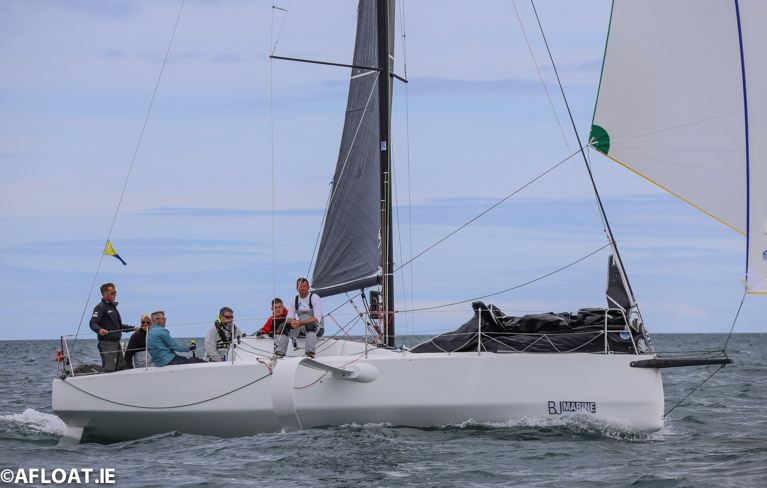 Beneteau's foiling Figaro 3 is one of the models proposed
Beneteau's foiling Figaro 3 is one of the models proposed
World Sailing received 12 responses from manufacturers and designers who provided information such as technical data including production capacity, handicap certificates, statements of suitability for double-handed sailing, sailors endorsements and existing fleet sizes.
The following manufacturers and classes responded to the RFI:
- Dehler 30 OD
- Django 8s
- FarEast 28 R
- Figaro 3
- J88
- J99
- J105
- JPK1030
- L30
- Sunfast 3300
- TEN2
- Vector6.5
At World Sailing's 2019 Annual Conference in Bermuda, World Sailing's Council, the main decision-making body of World Sailing, approved the decision-making process for the selection of Equipment for the Event.
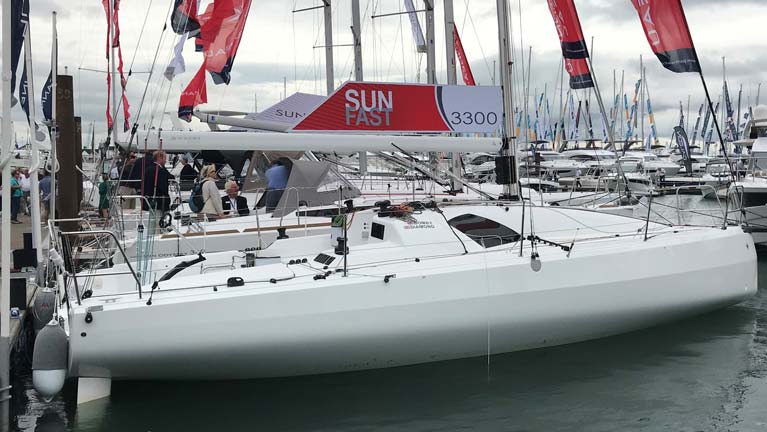 The new Sun Fast 3300 on the dock
The new Sun Fast 3300 on the dock
The criteria for suitable Equipment for the Olympic Offshore Event will be published no later than 31 December 2020 and the Equipment will be selected no later 31 December 2023. With regards to the qualification events, a list of Equipment that meets the qualification criteria shall be published no later than 31 December 2020. It is expected that the criteria will give the widest possible choice of suitable equipment, giving many manufacturers the opportunity for their equipment to be selected.



























